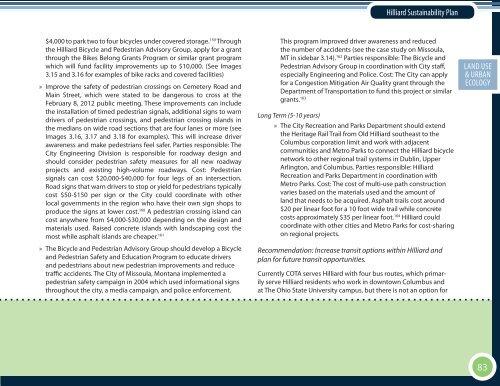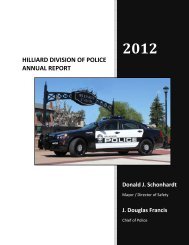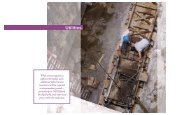The City of Hilliard Sustainability Plan
The City of Hilliard Sustainability Plan
The City of Hilliard Sustainability Plan
Create successful ePaper yourself
Turn your PDF publications into a flip-book with our unique Google optimized e-Paper software.
<strong>Hilliard</strong> <strong>Sustainability</strong> <strong>Plan</strong>$4,000 to park two to four bicycles under covered storage. 159 Throughthe <strong>Hilliard</strong> Bicycle and Pedestrian Advisory Group, apply for a grantthrough the Bikes Belong Grants Program or similar grant programwhich will fund facility improvements up to $10,000. (See Images3.15 and 3.16 for examples <strong>of</strong> bike racks and covered facilities)» Improve the safety <strong>of</strong> pedestrian crossings on Cemetery Road andMain Street, which were stated to be dangerous to cross at theFebruary 8, 2012 public meeting. <strong>The</strong>se improvements can includethe installation <strong>of</strong> timed pedestrian signals, additional signs to warndrivers <strong>of</strong> pedestrian crossings, and pedestrian crossing islands inthe medians on wide road sections that are four lanes or more (seeImages 3.16, 3.17 and 3.18 for examples). This will increase driverawareness and make pedestrians feel safer. Parties responsible: <strong>The</strong><strong>City</strong> Engineering Division is responsible for roadway design andshould consider pedestrian safety measures for all new roadwayprojects and existing high-volume roadways. Cost: Pedestriansignals can cost $20,000-$40,000 for four legs <strong>of</strong> an intersection.Road signs that warn drivers to stop or yield for pedestrians typicallycost $50-$150 per sign or the <strong>City</strong> could coordinate with otherlocal governments in the region who have their own sign shops toproduce the signs at lower cost. 160 A pedestrian crossing island cancost anywhere from $4,000-$30,000 depending on the design andmaterials used. Raised concrete islands with landscaping cost themost while asphalt islands are cheaper. 161» <strong>The</strong> Bicycle and Pedestrian Advisory Group should develop a Bicycleand Pedestrian Safety and Education Program to educate driversand pedestrians about new pedestrian improvements and reducetraffic accidents. <strong>The</strong> <strong>City</strong> <strong>of</strong> Missoula, Montana implemented apedestrian safety campaign in 2004 which used informational signsthroughout the city, a media campaign, and police enforcement.This program improved driver awareness and reducedthe number <strong>of</strong> accidents (see the case study on Missoula,MT in sidebar 3.14). 162 Parties responsible: <strong>The</strong> Bicycle andPedestrian Advisory Group in coordination with <strong>City</strong> staff,especially Engineering and Police. Cost: <strong>The</strong> <strong>City</strong> can applyfor a Congestion Mitigation Air Quality grant through theDepartment <strong>of</strong> Transportation to fund this project or similargrants. 163Long Term (5-10 years)» <strong>The</strong> <strong>City</strong> Recreation and Parks Department should extendthe Heritage Rail Trail from Old <strong>Hilliard</strong> southeast to theColumbus corporation limit and work with adjacentcommunities and Metro Parks to connect the <strong>Hilliard</strong> bicyclenetwork to other regional trail systems in Dublin, UpperArlington, and Columbus. Parties responsible: <strong>Hilliard</strong>Recreation and Parks Department in coordination withMetro Parks. Cost: <strong>The</strong> cost <strong>of</strong> multi-use path constructionvaries based on the materials used and the amount <strong>of</strong>land that needs to be acquired. Asphalt trails cost around$20 per linear foot for a 10 foot wide trail while concretecosts approximately $35 per linear foot. 164 <strong>Hilliard</strong> couldcoordinate with other cities and Metro Parks for cost-sharingon regional projects.Recommendation: Increase transit options within <strong>Hilliard</strong> andplan for future transit opportunities.Currently COTA serves <strong>Hilliard</strong> with four bus routes, which primarilyserve <strong>Hilliard</strong> residents who work in downtown Columbus andat <strong>The</strong> Ohio State University campus, but there is not an option forECON. EXECUTIVELAND DEV. USESOCIAL SUMMARY& URBAN EQ.ECOLOGY83






